Power is not limited to the simple equation of voltage multiplied by current. From calculating the efficiency of a home appliance to determining the range of a cell tower, power measurement has a major role to play in today’s systems. This article takes you through, very briefly, the latest trends in power analysers, power meters and power supplies
Anagha P and Jai Sachith Paul
The growing demand for energy-efficient systems in electronics industry has led to advancements in design and test engineering. There is an increasing popularity for power measurement devices across different industry verticals, such as battery-operated portable device design, UPS and motor drive manufacturing, energy STAR power measurements, consumer appliance manufacturing and lighting. Precise and fast measurement of power and related parameters is possible with today’s power supplies, power meters and power analysers. Let us explore the latest technologies and innovations in the power measurement industry that have helped our design engineers to come up with better, energy-efficient products.

Trends in the industry
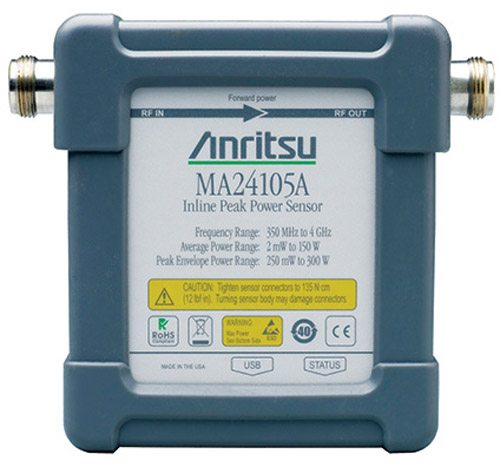
While power supplies are becoming extremely efficient, the need for portable designs and low-power-consumption designs are key driving factors in power analysis segment. Given below are the details of a few trends we find in the power measurement sector.
Faster measurement. A good measurement device responds quickly to changes in input levels, ensuring that the user gets good data even under variable conditions. Real-time measurement and analysis of power is now made possible with high-speed data delivery from the power sensors to power meters. The fast data acquisition and transfer helps in reducing the time required for measurement. This also helps make precise measurement of factors like rise time, fall time, overshoot and undershoot. Measurement speed of up to 10,000 samples per second is achieved using models like Keysight’s U2040 X-series.
High accuracy. There are applications, like mobile base-station power calculation, where one should accurately measure the power; slight variations in measured data will lead to large coverage differences. Modern power meters guarantee a high-level accuracy of approximately ±0.2dB, both in lab and field. This helps in characterising the devices more precisely, to have tighter test limits and be more accurate in fixture calibration. Power analysers like Tektronix’ PA4000 offer a basic accuracy of 0.05 per cent.
Auto-ranging. Auto-ranging or auto-selecting output characteristics make a power supply much more flexible than rectangular, or traditional, output characteristic power supplies because it expands the power curve, giving the user more voltage and current combinations in a single power supply. “It is like having many rectangular power supplies in one,” comments Asish Jain, application engineer at Keysight Technologies. Power supplies such as Keysight’s N8900 series and Tektronix’ PA4000 series feature this capability.
Integrated instruments. The general trend of integrating multiple instruments into one system is also seen in the power segment. Latest test systems combine instruments like oscilloscopes, power supplies, multimeters, signal generators and data loggers into a single system. High-definition oscilloscope (HDO) with power-analyser function introduced by Teledyne LeCroy, PX8000 power scopes by Yokogawa and advanced power system (APS) family by Keysight are examples.
Buying a power supply
A variety of AC and DC power sources are available in the market today, ranging from basic to complex models, with a wide range of available capabilities. Given below are a few factors to consider while buying a power supply for your applications.
V & P ratings. The first thing to consider while buying a new power supply is the voltage (V), current (I) and power (P) ratings required for your target application. Voltage of the supply should neither be too high nor too low as compared to the desired voltage value for the system you want to power. The type of voltage (AC or DC) is also very important. Another requirement is that the current rating of the power supply should be equal to (or greater than) the current necessary to run the system.
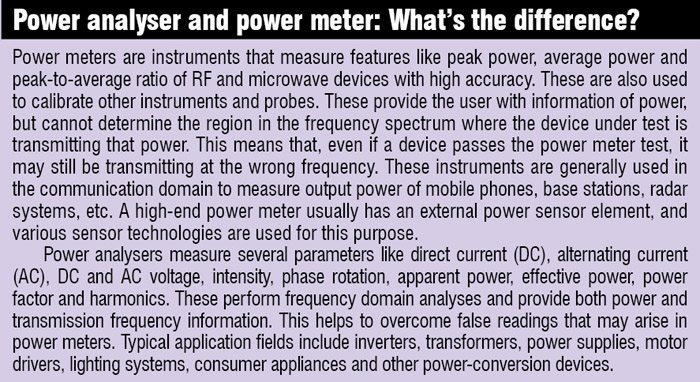
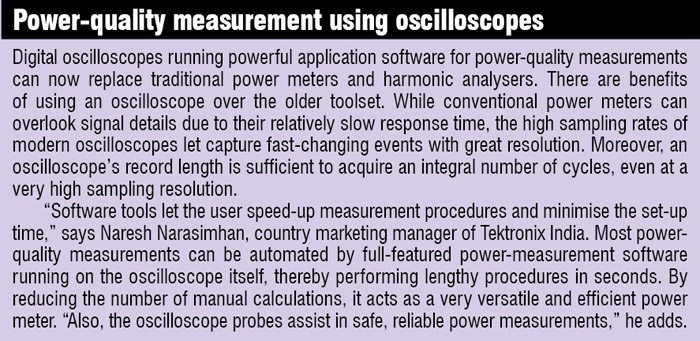 Programming capabilities and interfaces. Programmable power supplies allow the user to remotely control its operation through programming via analogue DC signal or digital interfaces like LXI, GPIB (or IEEE-488), Modbus TCP/RCU, RS-232, RS-485 and USB.
Programming capabilities and interfaces. Programmable power supplies allow the user to remotely control its operation through programming via analogue DC signal or digital interfaces like LXI, GPIB (or IEEE-488), Modbus TCP/RCU, RS-232, RS-485 and USB.
Protection. Having integrated power-protection measures help safeguard the instrument, and is very critical while testing costly systems. Over-voltage protection (OVP) and under-voltage protection (UVP) shuts down the supply when outputs are above (OVP) or below (UVP) the predefined trigger point. Over-current protection (OCP) shuts down any circuit that pulls a power higher than the power limit. There are other in-built features like over-temperature protection (OTP), over-load protection (OLP), short-circuit protection (SCP) and no-load operation (NLO) available in different models.
VI quadrants. There are three types of power supplies: single-quadrant supply that has output channels capable of only sourcing current; two-quadrant supply that can source and sink current in one voltage polarity; and four-quadrant power supply that is capable of sourcing and sinking currents in both positive and negative voltages.
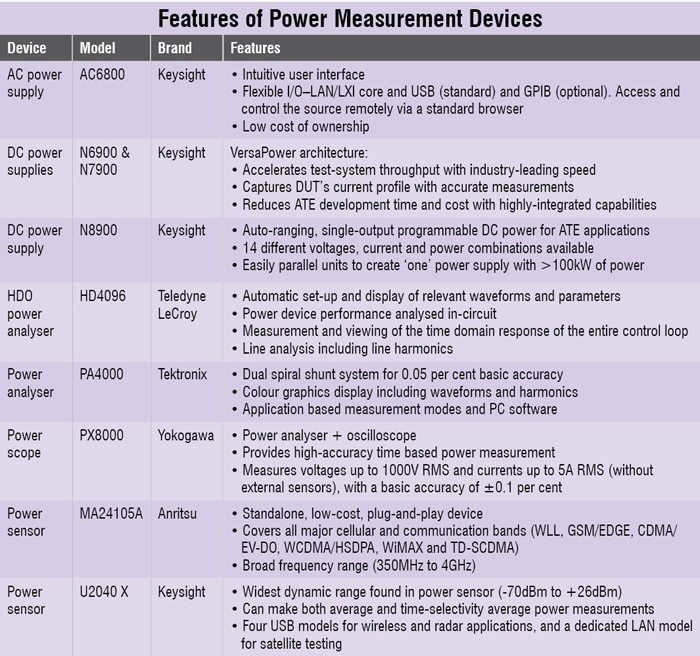
Speed and accuracy. The speed with which voltage output can be varied and current be measured affects the total output capacity, especially for a large production system. Some power supplies are provided with test extensions that provide high-speed reading with good accuracy, especially for viewing high-speed transient or pulse events.
Buying a power sensor
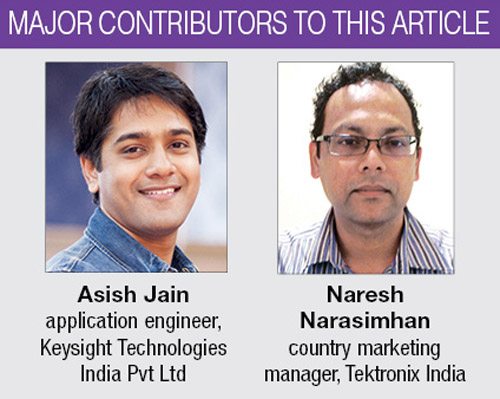 As mentioned earlier, a high-end power meter generally has an external power sensor associated with it. Due to the large variance in product offerings and specifications, a detailed comparison is the best way to evaluate power sensors before making a purchase decision. Listed below are some of the factors to consider while buying a power sensor.
As mentioned earlier, a high-end power meter generally has an external power sensor associated with it. Due to the large variance in product offerings and specifications, a detailed comparison is the best way to evaluate power sensors before making a purchase decision. Listed below are some of the factors to consider while buying a power sensor.
1. Basic factors like frequency range, power range, dynamic range, accuracy and speed of measurement required for the potential application(s)
2. Type of power to be measured—continuous wave (CW), average or peak power
3. Pulse width, pulse repetition interval (PRI) and other pulse parameters requirement in case of pulse signals
4. Internal zero and calibration support
5. Voltage standing wave ratio (VSWR) specification
6. Triggering modes
7. PC-connectivity software and tools
Boosting efficiency and clean energy
We are seeing several initiatives across the globe with an aim to use power more efficiently—the ‘20-20-20’ goal put forward by the European Union (EU) to reduce the present primary energy consumption by 20 per cent by the year 2020, and the transition of places like Djibouti, Tuvalu and many parts of Germany into 100 per cent energy-efficient regions, to name a few. This drive for a new, stable and affordable energy landscape, along with the changing policies, has opened up immense possibilities for the near future and has compelled many big players in the test and measurement industry to join the power sector. With such enormous trends happening in the industry, we can expect more innovations and breakthroughs in power measurement sector.
The authors are from EFY Bengaluru







